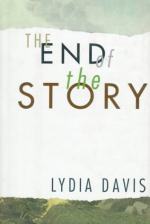|
This section contains 595 words (approx. 2 pages at 400 words per page) |

|
End of the Story Summary & Study Guide Description
End of the Story Summary & Study Guide includes comprehensive information and analysis to help you understand the book. This study guide contains the following sections:
This detailed literature summary also contains Quotes and a Free Quiz on End of the Story by Lydia Davis.
The following version of this book was used to create the guide: Davis, Lydia. The End of the Story. Picador, 1995.
Lydia Davis's novel The End of the Story is written from the first person point of view, and employs both the past and present tenses. Davis defies traditional notions of plot and structure in this work, and scenes in the past, present, and future often intersect or overlap one another. The following summary adheres to a linear mode of explanation, and relies upon the present tense.
When the unnamed first person narrator is in her mid-thirties, she moves to the West Coast to start a new teaching job at a coastal college. She moves into an old house with a woman named Madeleine, with whom she soon becomes close. Not long later, she attends a reception, where she meets a 22-year-old attractive student. That night, the narrator, the student, and her friends go to a café together. Afterwards, the narrator and the student buy beer at a local grocery store, and go back to her house. They spend the night together, and their love affair begins.
Soon the lover begins seeking out the narrator both on and off campus. They quickly develop a pattern to their relationship. Though the lover lives only a mile from the narrator, she does not like spending time at his home. When the narrator and the lover are not together, the narrator works on her classes and her writing. When they are together, she feels content. However, towards the middle of their relationship, she starts noticing things about the lover that she does not like. He seems irresponsible and young. His friends are uninteresting and immature. Worse, the lover appears reliant on women to ground him in the world.
When the narrator returns from a trip to the East Coast, the lover tells her that he has met someone new, and that their affair is over. The narrator does not want to believe him. For the next five days, she stalks him around town, desperate to convince him to come back to her. After the five days, she decides to stop going after him with such intensity. Despite this resolution, she cannot stop thinking about the lover. She calls him often. She shows up at the gas station where he works. She invites him to party after party. She cannot understand what happened, nor why she feels so much pain.
She starts writing about the lover. The more she writes about him, the less real he seems. Then the lover asks if he can move into her garage. When the narrator does not let him, the lover asks if he can store his belongings in the garage instead. A few months later, he moves his things out of the garage. This is the last time the narrator sees him.
A few years later, the narrator visits the desert with another man. She wanders off by herself, and finds the lover's last address. Afterwards, she stops in a bookshop and drinks a cup of bitter tea.
Years later, the narrator is living on the East Coast with her partner, Vincent. Though much time has passed since her breakup with the lover, she cannot stop trying to turn their story into fiction. She labors endlessly over the novel, doubting every approach to the project. With time, the work grants her perspective on the relationship and the breakup. She realizes that the bitter cup of tea marks the end of her story with the lover, and thus her novel.
Read more from the Study Guide
|
This section contains 595 words (approx. 2 pages at 400 words per page) |

|



